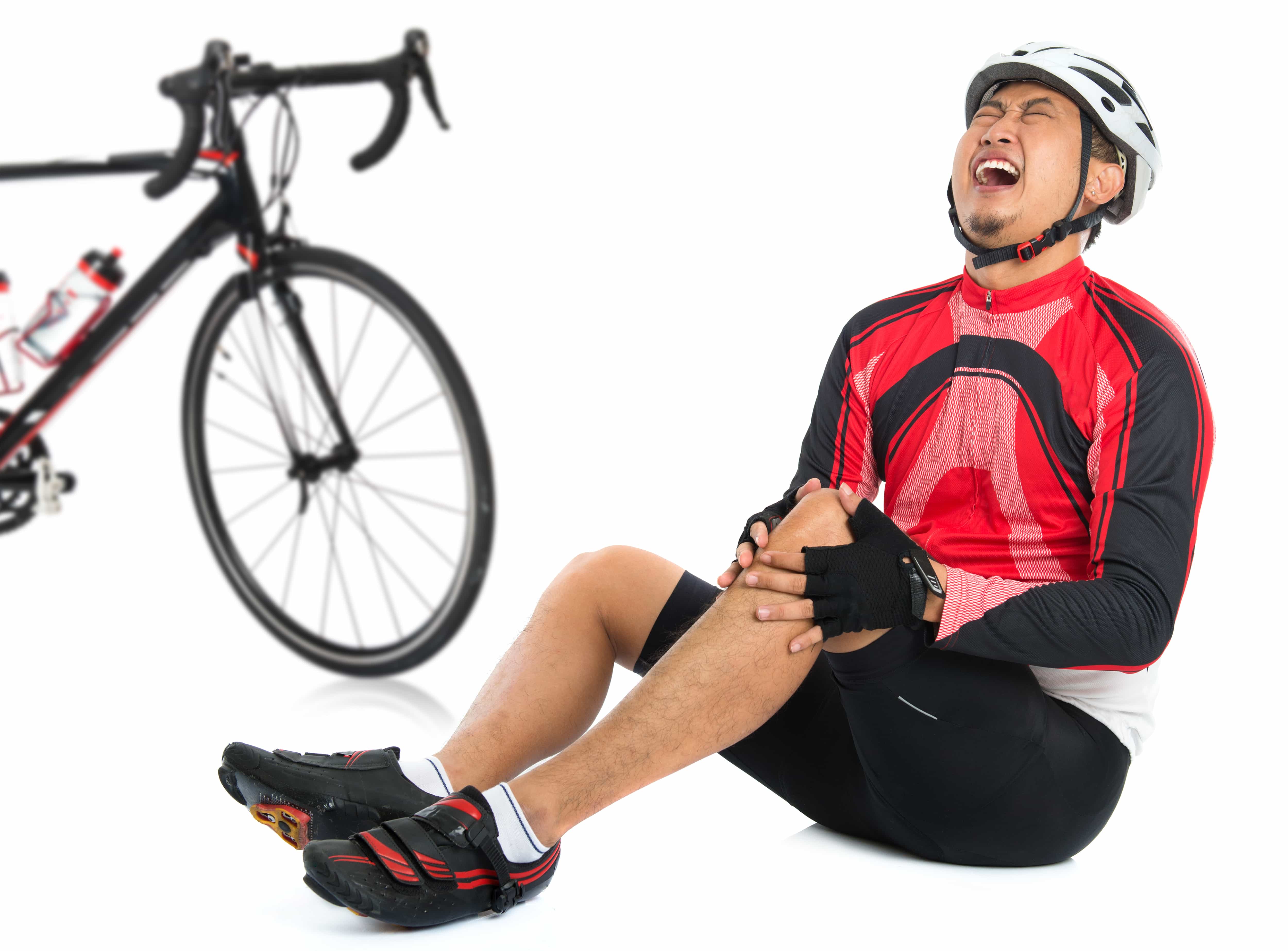For millions of people around the world, bicycling is a popular form of exercise, recreation, competition, and transportation that offers many health benefits. However, it also poses a risk of injury, and muscle injuries are a common occurrence among bicyclists. One of the most common muscle injuries for bicyclists is Patellofemoral Pain Syndrome (“PFPS”), which is also known as “cyclist’s knee.” PFPS is pervasive and debilitating in the cycling world.
PFPS is a condition that affects the knee joint, specifically the patella (knee cap) and the femur (thigh bone) and is characterized by pain and discomfort in the front of the knee, especially during activities that involve knee flexion, such as cycling. Understanding the causes, prevention, and management of PFPS is important for anyone who is involved in cycling in any capacity.
What Is Patellofemoral Pain Syndrome?
Patellofemoral Pain Syndrome is a common knee injury that affects individuals of all ages but is most commonly seen in young, active individuals. It is characterized by pain and discomfort in the front of the knee, specifically around the patella (knee cap) and the femoral condyle (bottom of the thigh bone), especially during activities that involve knee flexion, such as cycling, running, and jumping.
Symptoms of PFPS can include pain and discomfort around the kneecap, especially when climbing stairs, squatting, or sitting for long periods of time. Pain can also be felt when the knee is bent, such as when cycling or running. The knee may also feel weak or unstable and may give way.
Causes and Risk Factors for PFPS
The exact cause of PFPS is not fully understood, but it is believed to be the result of a complex combination of factors, which include overuse, poor bike fit, weakness in the quadriceps and hip muscles, poor cycling technique, biomechanical issues, and improper cleat alignment or wear.
Overuse is a major risk factor for the development of PFPS, because cycling for long distances or for extended periods of time can put a lot of stress on the knee joint. Similarly, poor bike fit can lead to improper alignment of the knee joint, which can put extra stress on the knee and lead to PFPS. Individuals who have a history of knee injuries or who have a high-arched or flat foot may be at increased risk for developing the condition.
Weakness in the quadriceps can contribute to the development of PFPS because these muscles are responsible for stabilizing the knee joint and keeping it in proper alignment. When they are weak, imbalances in the knee joint can occur, which can put extra stress on the knee and lead to PFPS. Similarly, the hip muscles, including the glutes, are responsible for stabilizing the hip joint and controlling the movement of the leg. Weakness in the hip muscles can cause the knee to move in an abnormal way, leading to increased stress on the knee joint.
Poor cycling technique is another risk factor for the development of PFPS. Incorrect cycling techique, such as using the wrong gear or not using the proper pedaling technique, can put extra stress on the knee and lead to PFPS.
Biomechanical issues, such as overpronation or malalignment of the foot and ankle, can also contribute to the development of PFPS. Malalignment of the patella in relation to the femoral condyle, known as patellar maltracking, is also believed to result in PFPS. This can occur due to structural abnormalities, such as shallow femoral groove or a high riding patella or due to muscle imbalances, such as weakness in the quadriceps and hip muscles.
Improper cleat alignment or wear can also be a significant contributing factor to the development of PFPS. Improper cleat alignment can occur when the cleats are positioned too far forward or backward on the shoe. This can cause the rider to adopt a knee position that is not biomechanically optimal, which puts increased stress on the knee joint. Cleats that are worn down or have lost their grip can also cause problems, as they may not hold the foot securely in place, which can lead to sliding and twisting of the foot on the pedal. This can cause abnormal forces to be transmitted through the knee joint.
Proper cleat alignment is critical to preventing PFPS. To ensure proper alignment, the ball of the foot should be directly over the center of the pedal spindle. The cleats should also be adjusted so that the knee is slightly bent when the pedal is at its lowest point. This will help ensure that the knee is in a neutral position and not excessively bent, which can lead to stress on the knee joint.
Additionally, it is important to regularly check the wear of the cleats and replace them when they are worn down. Cleats that have lost their grip or have become worn down will not provide adequate support, and they can lead to poor biomechanics and increased stress on the knee joint.
Symptoms of PFPS
Symptoms of PFPS include pain and discomfort in the front knee. The pain may be dull or achy, and it may be worse after sitting for long periods of time or after activity. Swelling and stiffness may also occur. There also may be a popping or creaking sensation in the knee joint. In some cases, there may be visible swelling or redness around the knee.
Diagnosis of PFPS typically invovles a physical examination and a review of the individual’s medical history. Imaging tests, such as X-rays or MRI, may be used to rule out other potential causes of knee pain. In some cases, a diagnostic injection may be used to confirm the diagnosis.
Treatment and Prevention of PFPS
Treatment for PFPS generally begins with non-surgical methods, such as rest, physical therapy, and the use of over-the-counter pain medications.
To prevent and manage PFPS, it is important to address the underlying causes of the condition. This includes having a proper bike fit; strengthening the quadriceps, hip muscles, and core muscles; learning proper cycling techinque; and using proper gear – orthotic inserts and patellofemoral taping. Stretching and foam rolling can also be helpful in managing the symptoms of PFPS. In addition, PFPS prevention includes maintaining a healthy weight and warming up properly before participating in physical activity.
Setting your bike up properly can help relieve some of the pressure on your knees and prevent PFPS. This includes (1) setting pedal cadence to 90 to 120 revolutions per minute, (2) raising the seat, (3) pushing the seat backwards, and (4) stablizing your feet with inserts. By raising the seat, it will distribute the force to your glutes and hamstrings, which takes pressure off critical knee supports – the quadriceps and patellar tendon. This will also reduce knee strain by decreasing the range of movement when cycling. When your body weight is directly above your knees, a large amount of force goes through them; by moving the seat backwards, it reduces the pressure on your knees. Finally, rocking feet add strain to your knees, so putting inserts beneath your heels addresses that issue.
Physical therapy and rehabilitation can also be beneficial for managing PFPS. Physical therapists can work with patients to develop a personalized exercise program that targets the muscles that support the knee joint. They can also provide manual therapy to reduce pain and inflammation and teach patients proper stretching and strengthening exercises.
Fixing poor cycling technique can help manage PFPS. A common poor technique is riding with the saddle too low. When the saddle is too low, it forces the cyclist to extend their knee more than necessary, putting increased stress on the knee joint. Another poor technique is riding with the cleats positioned too far forward or backward on the shoe, which can cause the rider to adopt a knee position that is not biomechanically optimal, putting increased stress on the knee joint. Poor cycling technique can also include riding with poor form, such as rounding the back or hunching the shoulders, which can lead to muscle imbalances and increase stress on the knee joint.
Orthotic inserts and patellofemoral taping can also be helpful in managing the symptoms of PFPS. Orthotic inserts can be used to support the foot and ankle and help prevent overpronation, while patellofemoral taping can be used to provide support to the knee and help reduce pain and inflammation.
In some cases, surgery may be necessary to treat PFPS. Surgery can be used to correct any structrual issues in the knee joint, such as a malalignment or a cartilage tear. In particular, surgical options may include arthroscopy, debridement, realignment, and reconstruction of the knee.







Leave A Comment